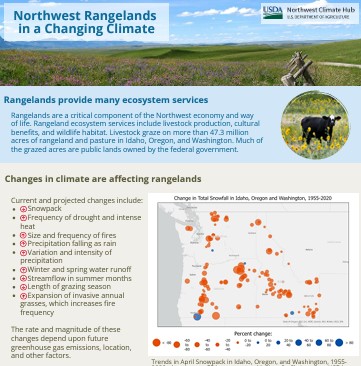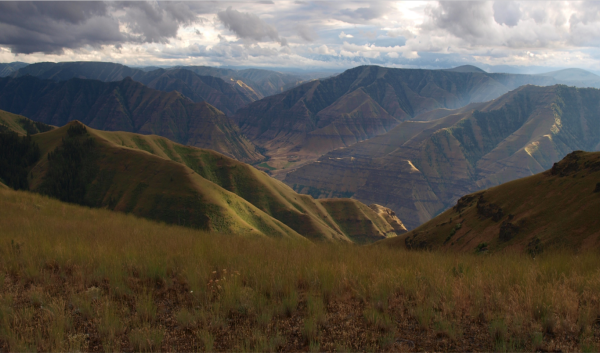Estimated reading time: 7 minutes
Key Points:
- Northwest grazing lands support millions of animals and contribute billions of dollars to the economies of Oregon, Idaho, and Washington.
- Increases in temperature will change the timing of grass emergence and affect the timing for forage availability.
- Snowpack acts as a reservoir of water and is expected to decline with climate change, which will reduce water availability in the summer for livestock and the plants they eat.
- Carbon dioxide will continue to increase in the future and affect plant productivity.
Grazing lands—specifically pastures, rangelands, and forest lands—are located throughout the northwestern United States. Non-irrigated pasturelands are common west of the Cascade Range in Oregon and Washington, whereas rangelands and irrigated pasturelands are typically located to the east. The western part of the region is significantly wetter and more forested, making the area less suitable for large beef cattle operations but good for dairy operations. This is partly because the Cascades cause more precipitation to fall on the west side, so land to the east of the mountains is drier. Much of this precipitation is caught by higher elevation mountains as snow and allows northwestern mountains to function as natural reservoirs which release cold water into streams and rivers as temperatures rise in the summer.

Livestock
The variable terrain and sagebrush habitat in the Northwest provide grazing lands for livestock. In addition to rangelands, the valleys and plateaus of Idaho, Washington and Oregon provide pasturelands, making this area ideal for raising livestock. Overall, land in this region supports millions of animals and contributes billions of dollars to the economy. In 2017, livestock in Oregon, Washington, and Idaho brought in a combined $8.4 billion in sales.
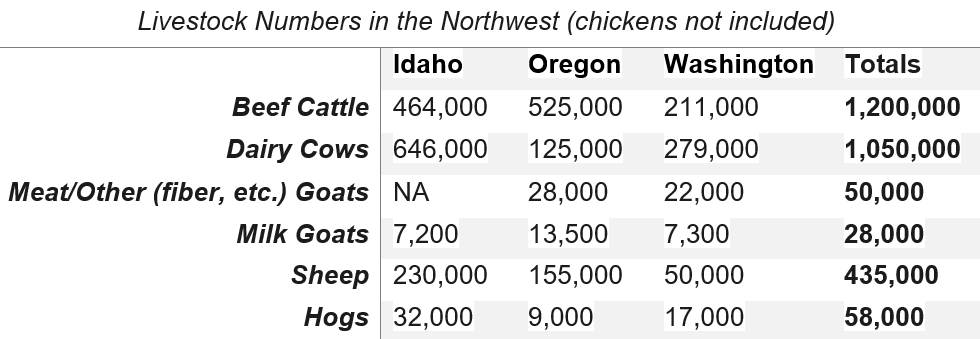
The Future of Grazing Lands in the Northwest
Climate change will have varying impacts on grazing lands and food supplies for livestock. Model projections for climate and greenhouse gas emissions show that:
- Temperatures will increase, altering the growing season and causing more heat stress in livestock.
- Precipitation timing, amount, and form (rain versus snow) will change, affecting water availability.
Increases in atmospheric carbon dioxide will directly affect plant productivity as well as temperature and precipitation in the Northwest. There is strong agreement among global climate models that temperatures in all seasons will increase in the Northwest, causing springtime warming to occur earlier. Climate models project a slight increase in average annual precipitation, but the projections for precipitation are more uncertain than those for temperature. There is high certainty that with higher temperatures, more precipitation will fall as rain rather than snow. Historically, as much as 37% of precipitation in the western United States has fallen as snow, generating up to 75% of water supplies in parts of the region. Because snow acts as a natural reservoir, warmer temperatures and less snow will alter streamflow and reduce water availability in the summer. Climate projections also show that summers will be drier and fall and winter wetter, along with more extremes—dry periods will be drier, and rain events will have heavier rainfall. Climate models project that along with warmer temperatures overall, spring will be warmer as temperatures rise earlier in the year.
How will this affect grazing lands and livestock in the Northwest?
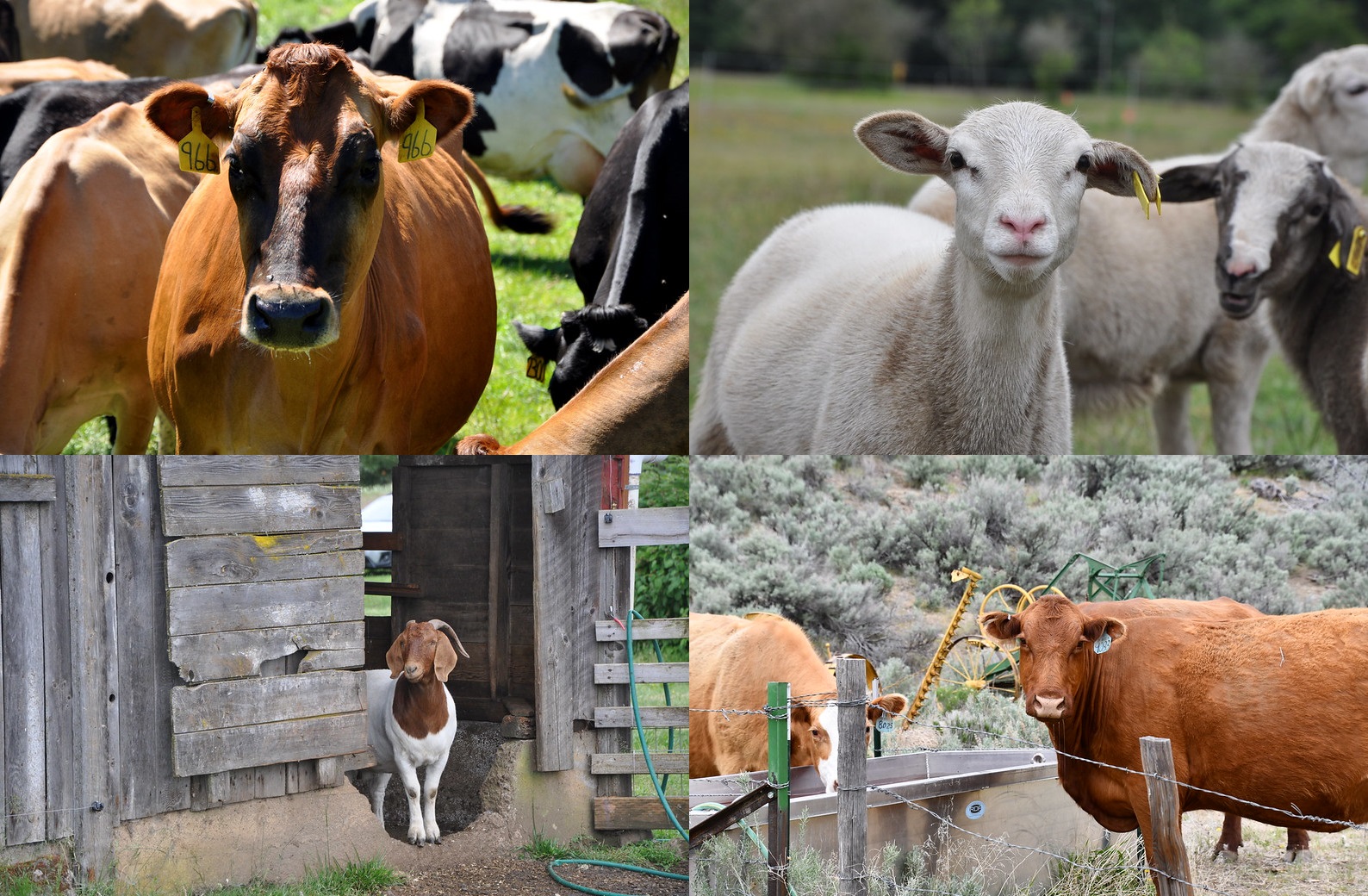
The condition of grazing lands and forage are crucial for healthy herds, so climate change effects on plant growth will affect livestock. Plants have upper and lower temperature limits, as well as an optimal growth temperature. This is particularly important for cultivated plants, which tend to be more temperate than the native plants of the Northwest. For cultivated plants, when temperature drops below this threshold, plant germination, growth, and development may be affected. When temperature exceeds this threshold, plants become less productive, especially in water limited environments. Work is underway to breed more drought tolerant species, which could help prepare for a warmer future. For hay specifically, there is an added threat of nutrient loss or fungal growth if air temperatures are high enough to cause internal temperatures of hay bales to exceed 110°F.
Native plants in rangelands are more tolerant of extreme temperatures. Some native plants require a certain number of chilling hours or freezing temperatures to complete seed germination, whereas some need hot temperatures for filled seeds to ripen. Increased temperature could affect native plants if chilling requirements are not met. Also, native plants can go dormant if temperatures exceed their high temperature threshold too early in the year, which improves plant survival, but reduces forage used by cattle.
Climate change will also affect the timing and quantity of forage availability for livestock. With temperatures rising earlier in the year, both springtime and grass emergence happen earlier. Altered timing of grass emergence may reduce livestock access to forage that emerges earlier, especially for herds that are grazed on federal lands using grazing permits with fixed grazing dates.
Reduced summer precipitation and higher summer temperatures will shorten the grazing season. Cattle graze at lower elevations earlier in the season and ranchers move their herds to higher elevations as snow melts. Earlier snowmelt may cause overlap of grass availability between low- and high-elevation rangelands, leading to reduced overall grass quantity. Altered precipitation patterns will affect streamflow and could reduce the availability of water for irrigation and impact hay production. Adding to this, increased temperatures and a longer growing season will put more stress on water systems for all of agriculture, which will reduce water available for livestock. This type of water stress has already been seen in the Northwest, particularly in the Klamath River Basin.
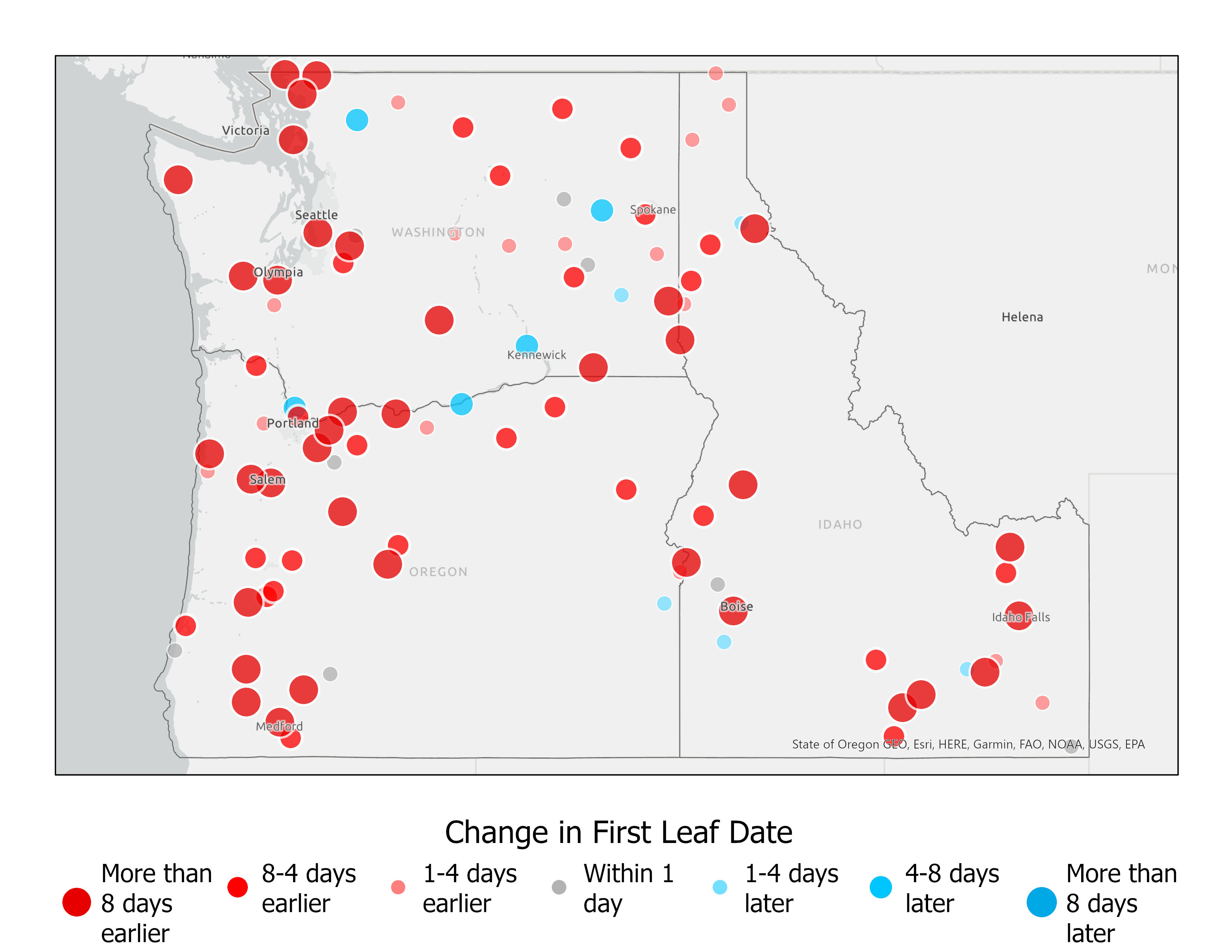
Although timing and quantity of forage will be affected by climate change, increased atmospheric carbon may improve the growth of some plant species, depending on nutrient availability. Increased concentration of carbon dioxide increases water efficiency in plants and can increase growth. Unfortunately, increased carbon has also been shown to reduce feed quality. This is important for cool-season grasses of the Northwest that have lower protein concentrations in a higher carbon atmosphere, which would reduce livestock growth. In addition, drought and limited availability of other nutrients may constrain increases in plant productivity with climate change.
Heat stress effects on livestock are an increasing concern because of more frequent temperature extremes and higher nighttime temperatures. Heat stress leads to decreased feed intake in cattle and can lead to hormonal responses that decrease reproductive efficiency and lactation. The impacts of higher temperatures will be greater when water is limited due to drought. During droughts, less water is available for livestock and for irrigation for pastures and growing hay. Drought periods reduce forage and water resources on rangelands as well. The Northwest may be able to supplement forage from drought-stressed grazing lands with feedstuffs from irrigated lands, but scarce water resources during drought may impede this effort.
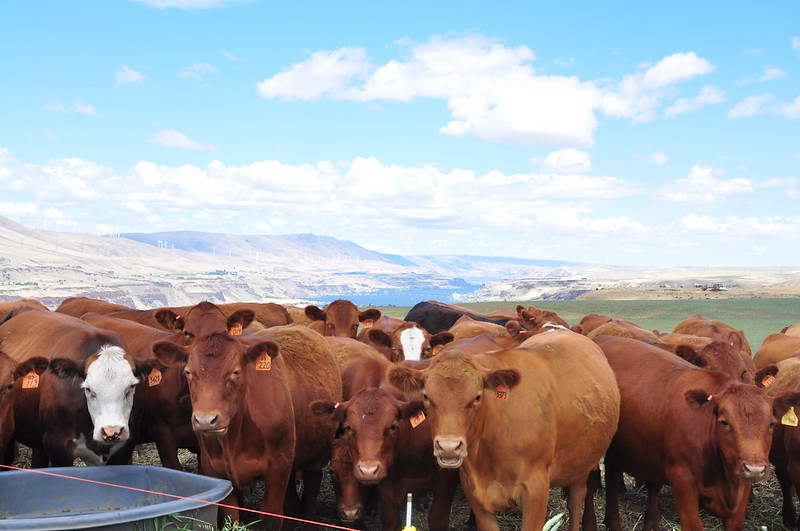
During droughts, ranchers may experience cash flow challenges because they need to purchase feed to supplement cattle diets, which is more expensive due to limited hay production. Adding to the cash flow challenge, calves will sell at a lower price because of their reduced growth. Although some parts of the Northwest have plentiful water, in drier parts of the region water management is expected to become more complex with climate change.
The increased frequency of wildfires will also pose challenges to the reliability of forage on grazing lands. In rangelands, invasive annual grasses capitalize on warmer, wetter winters, allowing them to expand up in elevation. This increases the flammability of vegetation. Invasive annual grasses also use up resources earlier in the spring, outcompeting native plants, promoting increased wildfire frequency. Livestock are often unable to return to grazing lands for a few years post-fire. This period of no grazing is intended to allow for the land to recover from fire and protect native plants and animals. However, this loss of grazing lands can be problematic if other forage resources are not available.
What other implications are there for ranchers, farmers, and their way of life?
Ranchers have dealt with extreme weather events including droughts in the past, but climate change is expected to make these events worse and occur more often. Although drought can be in the normal range of climatic variability, recent droughts were abnormally dry, and were intensified by climate change. It is hard to predict how extreme weather events such as droughts and floods may impact farmers and ranchers in the future, but for those who have already been impacted it has been difficult. Recent droughts, for example, caused economic impacts for many ranchers. To offset losses in ranch income, ranchers across the U.S. have had to seek employment off the ranch, and a number of young people have turned away from the profession all together. This loss is greater than economic, as many ranches have been in families for generations. Ranchers who are displaced from climate change lose their history, and this can lead to feelings of despair and hopelessness. Many ranchers struggle as a result, and so does their mental health. Climate change will affect ranching and farming, and there are ways to prepare for these changes.
What can farmers and ranchers do to prepare?
Ranchers can prepare for climate change with a number of adaptation options and programs. Practices such as lower stocking rates, shorter grazing periods, developing springs or providing multiple water sources to spread cattle out, and rotational grazing help ensure that rangeland plants will be resilient through times of environmental variability. For drought, management actions include diversifying grazing resources, using grazing to reduce fire risk, and restoring incised streams. Although agriculture will be affected by climate change, there are options for ranchers, farmers, and those who rely on them to adapt and reduce the biggest impacts.
- Climate change information
- Climate change adaptation actions
- Climate Change Vulnerabilities and Adaptation Strategies for Land Managers on Northwest US Rangelands
- Climate Change Adaptation Strategies for Rangeland Managers
- Management Actions for Northwest Grazing Lands from the Northwest Climate Hub
- Climate-Smart Resources from USDA Farmers.gov
- Conservation Programs - Natural Resource Conservation Service
- Washington State University list of resources for forage and pasture
- Pacific Northwest Pest Management Handbooks for Livestock
- Management strategies for optimal grazing distribution and use of arid rangelands
- A research paper on a climate change indicator framework for rangelands and pastures of the USA
- 2017 Ag Census Web Maps from USDA NASS that display geographic based data about hay and livestock
- Overview of livestock, their yield, and their economic value in:
- Livestock Breeds
- Livestock Information
- Mental Health Resources:


